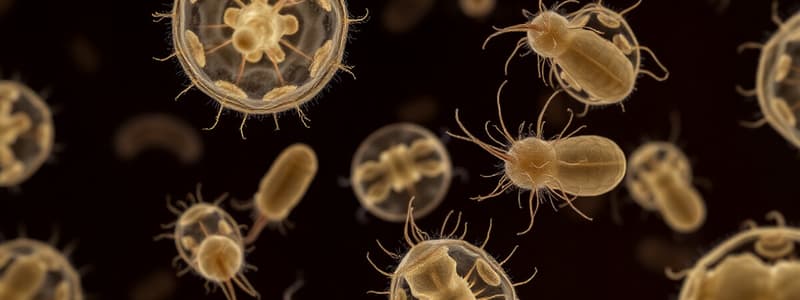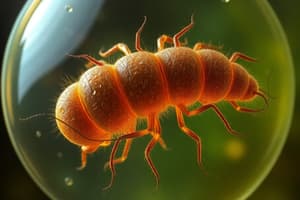Podcast
Questions and Answers
What is the primary genus that causes malaria in humans?
What is the primary genus that causes malaria in humans?
- Babesia
- Hemoproteus
- Leucocytozoon
- Plasmodium (correct)
Which malaria species is known to be the most fatal form in humans?
Which malaria species is known to be the most fatal form in humans?
- Plasmodium ovale
- Plasmodium vivax
- Plasmodium falciparum (correct)
- Plasmodium malariae
Which factor is noted as a primary influence on the distribution of malaria?
Which factor is noted as a primary influence on the distribution of malaria?
- Climatic factors (correct)
- Flora diversity
- Geological formations
- Urbanization rates
Where is Plasmodium knowlesi primarily distributed?
Where is Plasmodium knowlesi primarily distributed?
Which malaria species is predominantly found in West Africa?
Which malaria species is predominantly found in West Africa?
Which species was observed in Terengganu with a sample size of one?
Which species was observed in Terengganu with a sample size of one?
What is the sample size for P.cy found in Thailand according to the presented data?
What is the sample size for P.cy found in Thailand according to the presented data?
Which two species were detected together in Sabah with a combined sample size of six?
Which two species were detected together in Sabah with a combined sample size of six?
Which option accurately lists a species detected in both Sabah and Thailand?
Which option accurately lists a species detected in both Sabah and Thailand?
Which researcher's findings include a detection of P.P.in in archived blood samples?
Which researcher's findings include a detection of P.P.in in archived blood samples?
What defines an imported case of malaria?
What defines an imported case of malaria?
Which type of malaria case indicates local transmission with a direct link to an imported case?
Which type of malaria case indicates local transmission with a direct link to an imported case?
Which macaque species is NOT listed in association with knowlesi malaria in the provided content?
Which macaque species is NOT listed in association with knowlesi malaria in the provided content?
What is the significance of Anopheles mosquitoes in relation to P. knowlesi malaria?
What is the significance of Anopheles mosquitoes in relation to P. knowlesi malaria?
Which statement accurately describes an indigenous case of malaria?
Which statement accurately describes an indigenous case of malaria?
Flashcards
Plasmodium vivax
Plasmodium vivax
The most common malaria parasite worldwide.
Plasmodium falciparum
Plasmodium falciparum
The deadliest, most prevalent species found in tropical areas.
Malaria Distribution
Malaria Distribution
Malaria is primarily found in warm regions near the equator.
Malaria Parasite Phylum
Malaria Parasite Phylum
Signup and view all the flashcards
Plasmodium knowlesi
Plasmodium knowlesi
Signup and view all the flashcards
Imported Malaria Case
Imported Malaria Case
Signup and view all the flashcards
Introduced Malaria Case
Introduced Malaria Case
Signup and view all the flashcards
Indigenous Malaria Case
Indigenous Malaria Case
Signup and view all the flashcards
Knowlesi Malaria Distribution
Knowlesi Malaria Distribution
Signup and view all the flashcards
Zoonotic Malaria
Zoonotic Malaria
Signup and view all the flashcards
P.cy
P.cy
Signup and view all the flashcards
P.in
P.in
Signup and view all the flashcards
P.cy + P.in
P.cy + P.in
Signup and view all the flashcards
P.cynomolgi (P.cy) in Thailand
P.cynomolgi (P.cy) in Thailand
Signup and view all the flashcards
P.cynomolgi in different locations
P.cynomolgi in different locations
Signup and view all the flashcards
Study Notes
Introduction to Coccidia & Malaria
- Coccidia are single-celled, obligate intracellular protozoan parasites.
- They belong to the phylum Apicomplexa.
- Coccidia have a complex life cycle, usually involving more than one host.
- They have a sexual sporogonic phase and asexual schizogonic phase.
- All coccidia are parasitic organisms.
Lecture Outline
- Subtopic 1: General introduction to Coccidia and malaria
- Subtopic 2: Distribution and epidemiology of malaria
- Subtopic 3: Etiological agent of malaria
- Subtopic 4: Life cycle of the malaria parasite
- Subtopic 5: Pathogenesis and clinical features of malaria
Main Divisions of Protozoa
- Amoebae: Move by extending pseudopodia, e.g., Entamoeba
- Flagellates: Move by beating flagella, e.g., Trypanosoma
- Ciliates: Move by beating cilia, e.g., Balantidium
- Apicomplexa: Intracellular parasites, e.g., Plasmodium
Introduction to Coccidia
- Unicellular protozoa.
- Belong to the phylum Apicomplexa.
- Live intracellularly.
- Possess an apical complex for attachment and penetration.
- Found in body fluids or tissues.
- No specific locomotive organelle.
- Human parasites can cause severe infection in domesticated animals.
Taxonomy Classifications
- Malaria parasites are sporozoan parasites of the subclass Coccidia.
- The genus Plasmodium contains the causative organisms of malaria.
- Subtypes include vivax, falciparum, malariae, ovale, and knowlesi.
Malaria Classification
- Phylum: Apicomplexa
- Class: Aconoidasida (Subclass: Coccidia)
- Order: Hemosporida
- Genus: Plasmodium
Distribution & Epidemiology
- Plasmodium vivax is prevalent worldwide, predominately in tropics and subtropics.
- Plasmodium falciparum is the most prevalent malaria species, also found in tropics and subtropics, and is especially fatal.
- Plasmodium malariae is found in subtropical and temperate areas.
- Plasmodium ovale is confined to West Africa.
- Plasmodium knowlesi (monkey malaria) is prevalent in Southeast Asia.
Modes of Transmission
- Bite of an infected Anopheles mosquito
- Blood transfusion
- Organ transplant
- Congenital transmission
- Shared syringes
- Zoonosis (P. knowlesi)
Life Cycle of the Parasite
- Malaria parasites have a life cycle in two hosts:
- Definitive host: Female Anopheles mosquito
- Intermediate host: Man (or other mammals)
- The life cycle has two stages:
- Asexual phase (schizogony) occurring in humans
- Sexual phase (sporogony) occurring in mosquitos
Exo-erythrocytic Cycle
- Sporozoites are inoculated into the human host.
- They infect liver parenchymal cells (hepatocytes).
- Merozoites are released from the hepatocytes.
Erythrocytic Cycle
- Merozoites infect red blood cells.
- The parasite feeds on haemoglobin.
- Ring stage trophozoites mature into schizonts.
- Schizonts release merozoites, pigments, and toxic materials.
- Blood stage parasites cause clinical symptoms.
Sporogonic Cycle
- Mosquito ingests gametocytes.
- Microgametes penetrate macrogametes forming zygotes.
- Zygotes become motile, then become oocysts.
- Sporozoites are released to the salivary glands of the mosquito.
- Inoculation infects a new host.
Pathogenesis & Clinical Features
- Clinical manifestations are caused by the products of erythrocytic schizogony and the host's reaction to them.
- The disease process occurs due to the local or systemic response of the host to parasite antigens and tissue hypoxia caused by obstruction of blood flow due to parasitized erythrocytes.
Pathogenesis (P. falciparum)
- Erythrocytic schizogony occurs in organ capillaries.
- Changes in the surface of the infected erythrocytes causes them to stick together and to the endothelium causing congestion and blockade to blood flow leading to tissue hypoxia.
- A high level of parasitemia is common.
- Cytokines such as TNF are increased by infection.
Clinical Features
- Periodic bouts of fever with chills and rigors, followed by anaemia, splenomegaly (enlarged spleen) and hepatomegaly (enlarged liver).
- The classic febrile paroxysm has these three stages:
- Cold stage: chills and rigors, peripheral blood vessels constrict, cyanosis, headache, nausea (15 min to 1 hr)
- Warm/Hot stage: temperature peaks (39-41°C), intense heat, dilated blood vessels, flushed skin, headache, vomiting, possible convulsions (6–12 hr)
- Sweating/Profuse stage: temperature falls, exhaustion, cool moist skin, refreshed feeling, recovery (variable)
- Malaria's periodicity is typically as follows:
- Tertian (48 hours)
- Quartan (72 hours)
- Quotidian (24 hours)
- Variation in timing can occur due to mixed infections or multiple parasite broods.
Clinical Differences Between Malaria Species
- This table shows some of the key differences in incubation period, erythrocytic cycle length, relapses, and parasitemia between different Plasmodium species.
Malaria Vectors
- Malaria is transmitted by over 60 species of female Anopheles mosquitoes.
- Only the females bite to obtain blood meals for egg production.
Salivary Glands & Sporozoites
- The mosquito's salivary glands house sporozoites.
- Sporozoites are spindle-shaped.
Midguts & Oocysts
- Oocysts are seen in the mosquito's midgut.
Anemia
- Anemia occurs due to the rupture of infected red blood cells, complement-mediated, autoimmune haemolysis and hypersplenism.
Other Notes
- Important parasites and vectors are identified.
- Specific areas where specific types of parasite are found are identified.
- An evolutionary tree is presented.
Studying That Suits You
Use AI to generate personalized quizzes and flashcards to suit your learning preferences.
Related Documents
Description
Explore the world of coccidia and malaria in this informative quiz. Learn about the life cycles, pathology, and epidemiology of these single-celled protozoan parasites. This quiz covers various aspects including distribution, clinical features, and the classification of protozoa.




